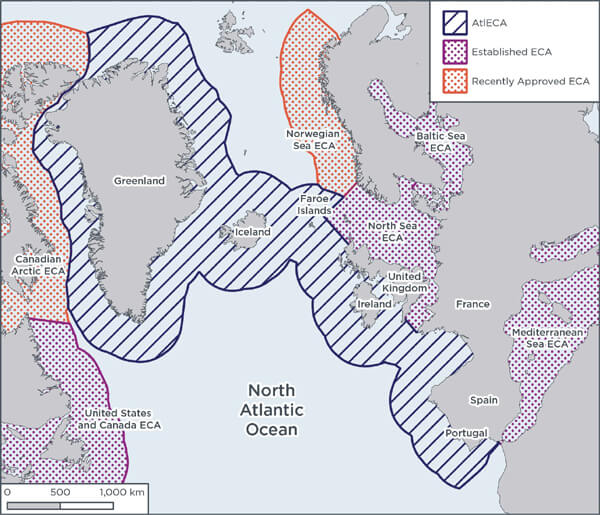NGO Calls for New Atlantic ECA Linking North America and Europe
Emission control areas in Northern Europe and along the North American coast have been found to contribute to the overall improvement in air quality. Against that background, the nearly 20-year-old NGO The International Council on Clean Transportation (ICCT) is releasing new research calling for connecting those zones to designate a much broader North Atlantic Emission Control Area.
ICCT released a 52-page report detailing its research in collaboration with Porto University. Along with its earlier work, the organization plans to submit the research to the International Maritime Organization’s Marine Environment Protection Committee calling for the designating of a new, much larger, ECA. This follows the recent agreement at the IMO to create new zones for the Mediterranean and the coastline of Norway.
“Despite substantial improvements in air quality due to land-based control measures across the proposed AtlECA region, the contribution of shipping emissions remains largely unaddressed,” the report asserts. They highlight that a third of global trade moves between North America, Europe, and other continents crossing this portion of the Atlantic. They deem it one of the world’s busiest shipping corridors.
The NGO proposes to designate a region that would reach as far south as Portugal and Gibraltar to join with the recently approved ECA for the Mediterranean. The proposed Atlantic region would connect the existing regions in the Baltic and North Sea and bridge across the Atlantic with the Faroe Islands, Iceland, and Greenland, before connecting to the existing zone for the Canadian Arctic and U.S./Canada Atlantic coastline.

ICCT calls for connecting the North American and European ECAs to create a new Atlantic zone (ICCT)
The report highlights that it would encompass an area where more than 193 million people live with especially vulnerable areas in Greenland with a large indigenous population and limited resources and infrastructure.
They assert that the limits within the new ECA could reduce sulfur dioxide concentrations by between 77 and 86 percent, while particulate matter would be reduced between 31 and 59 percent and nitrogen dioxide by three percent.
ICCT asserts demonstrable benefits including a reduction of between 2,900 and 4,300 premature deaths between 2030 and 2050. The cumulative economic value of these benefits it estimates could reach between €19 to €29 billion between 2030 and 2050.
“Establishing this emission control area is an opportunity to significantly reduce harmful emissions and improve public health for those living in coastal communities. We have found that the North Atlantic Emission Control Area could prevent thousands of premature deaths, while also delivering long-term economic and environmental benefits,” says Liudmila Osipova, ICCT Senior Researcher and Project Lead of this work.
In addition to health benefits, the new ECA ICCT says it could play a critical role in protecting the region’s marine biodiversity and cultural sites. The proposed AtlECA encompasses more than 1,500 marine protected areas, 17 important marine mammal habitats, and 148 UNESCO World Heritage sites. Reducing ship emissions, which contribute to pollution and ocean acidification, is essential for protecting these ecosystems.
They look to have the proposed ECA added to the agenda for the IMO’s MEPC meeting in 2025. They believe there are compelling benefits in expanding to the larger Atlantic zone and look to start the debate at the IMO.